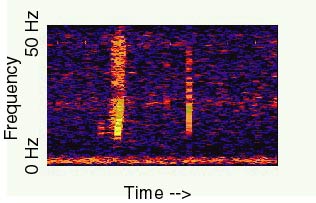Quoted from Cnn.com http://archives.cnn.com/2002/TECH/science/06/13/bloop/
LONDON, England -- Scientists have revealed a mysterious recording that they say could be the sound of a giant beast lurking in the depths of the ocean.
Researchers have nicknamed the strange unidentified sound picked up by undersea microphones "Bloop."
While it bears the varying frequency hallmark of marine animals, it is far more powerful than the calls made by any creature known on Earth, Britain's New Scientist reported on Thursday.
It is too big for a whale and one theory is that it is a deep sea monster, possibly a many-tentacled giant squid.
In 1997, Bloop was detected by U.S. Navy "spy" sensors 3,000 miles apart that had been put there to detect the movement of Soviet submarines, the magazine reports.
The frequency of the sound meant it had to be much louder than any recognised animal noise, including that produced by the largest whales.
So is it a huge octopus? Although dead giant squid have been washed up on beaches, and tell-tale sucker marks have been seen on whales, there has never been a confirmed sighting of one of the elusive cephalopods in the wild.
The largest dead squid on record measured about 60ft including the length of its tentacles, but no one knows how big the creatures might grow.
For years sailors have told tales of monsters of the deep including the huge, many-tentacled kraken that could reach as high as a ship's mainmast and sink the biggest ships.
However Phil Lobel, a marine biologist at Boston University, Massachusetts, doubts that giant squid are the source of Bloop.
"Cephalopods have no gas-filled sac, so they have no way to make that type of noise," he said. "Though you can never rule anything out completely, I doubt it."
Nevertheless he agrees that the sound is most likely to be biological in origin.
The system picking up Bloop and other strange noises from the deep is a military relic of the Cold War.
In the 1960s the U.S. Navy set up an array of underwater microphones, or hydrophones, around the globe to track Soviet submarines. The network was known as SOSUS, short for Sound Surveillance System.
The listening stations lie hundreds of yards below the ocean surface, at a depth where sound waves become trapped in a layer of water known as the "deep sound channel".
Here temperature and pressure cause sound waves to keep travelling without being scattered by the ocean surface or bottom.
Most of the sounds detected obviously emanate from whales, ships or earthquakes, but some very low frequency noises have proved baffling.
Scientist Christopher Fox of the U.S. National Oceanic and Atmospheric Administration's Acoustic Monitoring Project at Portland, Oregon, has given the signals names such as Train, Whistle, Slowdown, Upsweep and even Gregorian Chant.
He told New Scientist that most can be explained by ocean currents, volcanic activity -- Upsweep was tracked to an undersea South Pacific mountain that had not been identified as "live."
"The sound waves are almost like voice prints. You're able to look at the characteristics of the sound and say: 'There's a blue whale, there's a fin whale, there's a boat, there's a humpback whale and here comes and earchquake," he says.
But some sounds remain a mystery he says. Like Bloop -- monster of the deep?
Listen to the bloop and read more here: http://en.wikipedia.org/wiki/Bloop


















0 comments
Post a Comment